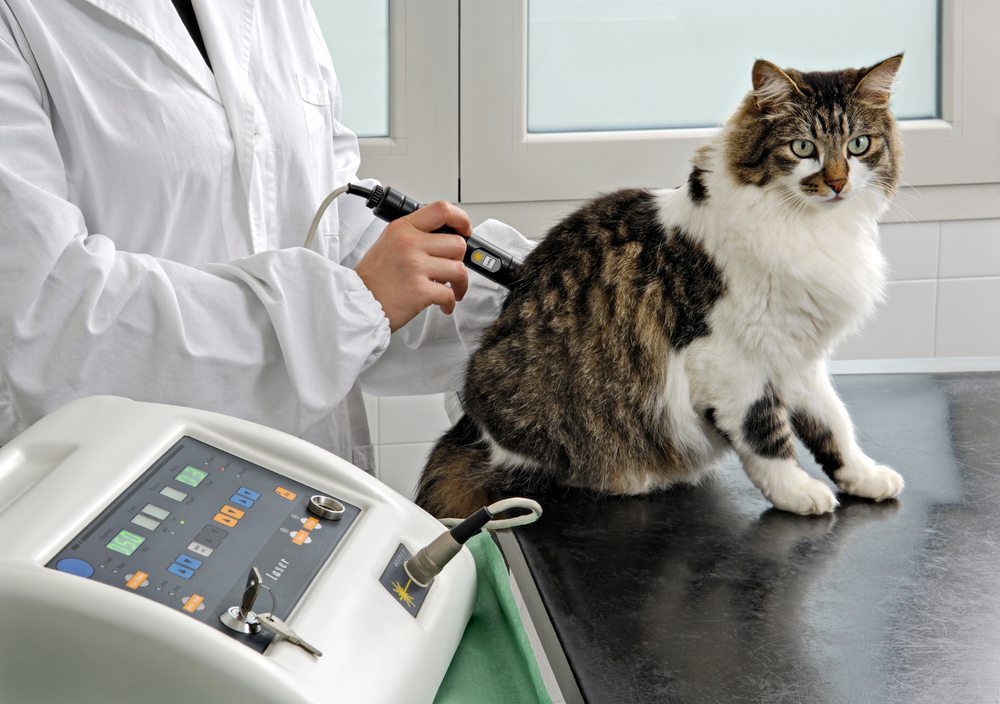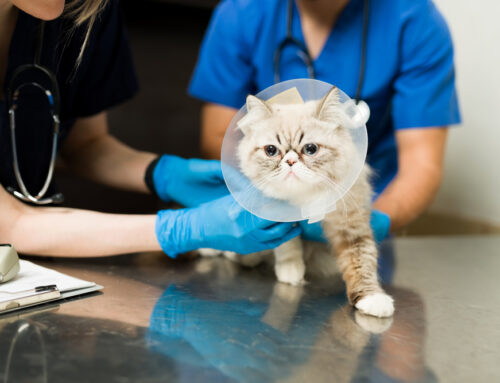Pain can be extremely debilitating for pets, but pain medications can have significant side effects. Laser therapy is a drug-free, non-invasive treatment modality that can help relieve your pet’s pain. Our Stack Veterinary Hospital team wants to provide information about laser therapy in pets to help you determine if your pet is a candidate.
Laser therapy in pets
Laser is an acronym for light amplification by stimulated emission of radiation, and is created by activating electrons to an excited state. When the electron moves from the excited state to the ground state, photons are released that form a light beam. The laser light is absorbed by tissues, creating photothermal and photochemical reactions that benefit the patient therapeutically by stimulating cell regeneration and increasing blood circulation. Laser light properties include:
- Monochromatic — Unlike natural light, laser light is emitted in a single wavelength, which allows light production targeted for absorption by specific tissues and for a specific purpose.
- Coherent and collimated — Coherence means the photons emerge from the laser and travel in the same phase and direction. Collimation means the light emitted from the laser does not diverge. These properties allow the laser to penetrate the skin, treating only a small area and minimizing unwanted effects to adjacent tissues.
When photons are absorbed, adenosine triphosphate (ATP) (i.e., a compound that enhances cellular metabolism, potentially accelerating tissue repair and cell growth) is produced. In addition, the laser stimulates stem cells and anti-inflammatory effects to reduce pain and promote healing.
Laser therapy benefits in pets
Laser therapy has no side effects, which means the treatment is ideal for use in conjunction with other treatment modalities to increase your pet’s pain relief and promote healing. Conditions that can be treated using laser therapy include:
- Arthritis — Laser therapy reduces swelling, inflammation, and pain in affected joints.
- Back pain — Laser therapy can reduce pain and help heal damaged nerves in pets affected by intervertebral disc disease (IVDD).
- Tendon and ligament injuries — Laser therapy may help improve collagen organization to promote healing in tendon and ligament conditions.
- Fractures — Laser therapy enhances callus formation and fracture healing.
- Soft tissue injuries — Laser therapy draws oxygen and nutrients to the damaged area, creating an optimal healing environment.
- Muscle spasms — Laser therapy can reduce muscle spasms and increase functionality.
- Post surgical pain — Laser therapy can help reduce pain after surgery, especially for orthopedic issues, reduce scar formation, and decrease inflammation to improve range of motion.
- Infections — Laser therapy can be used to address certain infection types.
- Lick granulomas — Laser therapy can help heal lick granulomas, although the exact mechanism is unknown.
- Dental disease — Laser therapy can decrease gum inflammation and address periodontal disease in pets.
Laser therapy is contraindicated in cancer patients, because the laser light can excite the cancer cells, causing them to spread.
Laser therapy pet candidates
Except for cancer patients, laser therapy is a great treatment modality for all pets. Those who can especially benefit include:
- Pets with an underlying health condition — Pets who have a condition such as liver disease, which prevents them from taking medications, can benefit from laser therapy’s pain relieving and healing properties.
- Cats — Cats are especially sensitive to pain control medications, and laser therapy is a great alternative, with no side effects.
- Uncooperative pets — Medication administration can be difficult in some pets, and laser therapy is a good option.
- Senior pets — Older pets may have diminished organ function, and laser therapy is a great choice to prevent stress on their system.
Laser therapy sessions in pets
When you bring your pet in for a laser therapy session, your pet and anyone who remains in the room during the treatment will need eye protection. We will place your pet in a comfortable area, and use a handheld device to deliver the laser treatment. An individual treatment can take from 10 to 30 minutes, depending on your pet’s condition, size, age, species, and skin and coat color. Some conditions show improvement after one treatment, but chronic issues may need several sessions over weeks or months to properly address the condition.
Laser therapy and other pet treatments

Therapeutic laser therapy is a great complement to other pain management strategies, including:
- Pharmacologic — Since laser therapy doesn’t have side effects, the treatment can be used in conjunction with your pet’s pain medication to help alleviate their discomfort.
- Non-pharmacologic — Laser therapy can also be paired with other treatment modalities, such as rehabilitation exercises, to help painful pets.
Laser therapy is an excellent method to provide non-invasive, drug-free relief to painful pets, and the treatment can also promote healing for numerous conditions. If you think your pet can benefit from this treatment modality, contact our American Animal Hospital Association (AAHA)-accredited team at Stack Veterinary Hospital to schedule a therapy session.







Leave A Comment